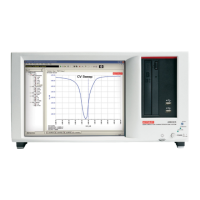3-134 Return to Section Topics 4200-900-01 Rev. K / February 2017
Section 3: Common Device Characterization Tests Model 4200-SCS User’s Manual
c. Use oscilloscope to determine appropriate PulseVoltage values for the desired V
G
and
V
D
, making sure to use the 1 M Ω input setting on the oscilloscope.
i. Drain: Connect the oscilloscope probe across the drain-source of the DUT.
ii. Use the Program and Erase UTMs to output pulses, while using the oscilloscope to
measure the pulse height. Iterate by modifying the PulseVoltages to reach the target
voltage.
7. Once the appropriate voltage levels are determined, the appropriate pulse width may be
determined by iteratively outputting pulses while occasionally measuring the V
T
.
a. Start by using a pulse width that is shorter than the expected PW. For example, if 20 μs
is the expected PW, try using a 2 μs PW.
b. Enter the parameter values into the Program UTM, following the procedure in Running
the Program or Erase UTM. Initially, set NumPulses = 2, or another small number.
c. Uncheck the Erase and Fast-Program-Erase tests.
d. Enter the parameter values for the Vt-MaxGm test, following the procedure in Running
the Vt-MaxGm ITM.
e. Run the test
i. Double-click 4Terminal-FloatingGate
ii. Press the Run button
f. Check the graph on the Vt-MaxGm test. It will likely be too low on the first few runs, but
note the total number of pulses sent to the DUT. Rerun test until the V
T
has met the
target value, and note the total pulse width to use to program the device, using either
the Program or Fast-Program-Erase tests.
g. Repeat the above step with the Erase test, feeding final results into the Erase and Fast-
Program-Erase tests.
h. Ensure that the erase parameters are fully erasing the DUT.
i. Set the parameters in the Fast-Program-Erase test. Set NumPulses = 10.
ii. Uncheck the Program and Erase tests.
iii. Double-click 4Terminal-FloatingGate. Press run.
iv. Note the V
T
.
v. Change NumPulses = 100 or a larger number.
vi. Double-click 4Terminal-FloatingGate. Press Append.
vii. Note the V
T
. If the V
T
value for the tests are similar, then the erase pulse is fully erasing
the DUT.
Running the Program or Erase UTM
These tests are located in all of the Flash projects. It outputs a number of pulses
(Parameter = NumPulses) with a shape shown similar to Figure 3-102, on a
number of pulse channels (Parameters = NumPulseTerminals, PulseTerminals).
1. Enter the number of pulse waveforms required into NumPulseTerminals. This must be a
minimum of one channel, up to a maximum of the number of channels available. For a
Flash system with 2 4205-PG2 cards, there are four pulse channels available.
2. Enter which pulse channels will be used into PulseTerminals. This is a string of channels, in
the form VPU1CH1,VPU1CH2,VPU2CH1,VPU2CH2. VPU1 is the 4205-PG2 in the lowest-
numbered slot (right-most slot when looking at back of 4200-SCS chassis).
a) The characters are all capitalized and each channel is separated by a comma.
b) No spaces are allowed in the PulseTerminals string.
3. Enter the values in the five arrays that define the pulse shape, referring to Figure 3-102 and
the instructions in Entering Segment ARB values into UTM array parameters. The number
of non-blank entries in the array must match NumPulseTerminals, as shown in Figure
3-104, NumPulseTerminals = 4, and the size of each array (PulseVoltagesSize,
PrePulseDelays, TransitionTimesSize, PulseWidthsSize, PostPulseDelaysSize) is also 4.

